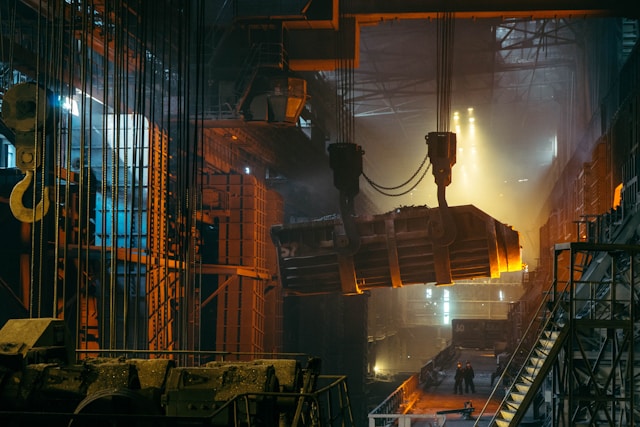Exploring the Steelmaking Process: From Ore to Alloy

How is Steel Made?
Steel, an alloy predominantly composed of Iron and Carbon, is a material that plays perhaps the biggest role in building modern society. From the cars we drive to the buildings we live in, steel is everywhere, providing the necessary structure and form.
Although, in the last few decades, pushes have been made to replace steel in various sectors, like automotive and aerospace, it remains the most critical material for humanity. Its unparalleled strength, durability, and versatility make it the material of choice for most industries globally, which probably won’t change soon.
But how is steel made today? Well, it depends because, unlike other materials, steel can be made from scratch or recycled easily without degradation. Let’s have a closer look!
Overview of the Steelmaking Process
Making steel doesn’t begin in the furnace or mold; it starts with extracting raw materials. Notably, the first step would be extracting and processing the iron ore, the naturally occurring mineral from which Iron is extracted. Iron ore makes up 5% of the Earth’s crust, which is why steel is humanity’s most famous building material.
Then, the iron ore is “smelted,” which includes melting the Iron in a blast furnace or electric arc furnace. Then, the ore is combined with coal or coke, which removes the impurities and other minerals, making the elementary Iron ready for steel production.
However, lately, recycled steel has been used more, contributing to sustainable practices by reducing the need for raw materials and energy.
The Blast Furnace Process Explained
In the blast furnace process, iron ore is first processed into sinter or pellets to facilitate quick and efficient smelting. Meanwhile, coal is converted into coke, which acts as a fuel for the furnace and a reducing agent. Limestone is also added as a flux.
Once the iron ore, coke, and limestone layers are fed into the furnace, a blast of hot air is introduced into the mix, igniting the coke. This produces high enough temperatures to melt the iron ore and produce Iron, limestone, and impurities.
BOS (Basic Oxygen Steelmaking) – the Next Step
BOS, or Basic Oxygen Steelmaking, follows the blast furnace operation and aims to reduce the carbon content of the molten material to produce steel.
Namely, steel consists of 0.3-2.1% Carbon, and blast furnace processing produces a material with a much higher percentage. BOS can reduce the carbon content by oxidizing the molten Iron and reacting with the Carbon to produce carbon monoxide and carbon dioxide. Other impurities like silicon, manganese, and phosphorus are also removed, resulting in a more refined steel.
However, steel production doesn’t stop there – the alloy is further purified using techniques like ladle furnace refining, vacuum degassing, and argon stirring. Finally, the chemical properties of steel are adjusted by adding various other elements, like Chromium, Nickel, Molybdenum, Vanadium, Tungsten, etc.
The Electric Arc Furnace (EAF) Method for Recycling Scrap Steel
The EAF process is mainly used in recycling scrap steel, and its importance has grown in recent years. In this process, steel is added to the furnace and then melted at very high temperatures achieved by electric arcs between carbon electrodes.
Generally, the Electric Arc Furnace method is faster and more energy efficient, but crucially, it reduces the reliance on raw materials. Moreover, it allows manufacturers to produce smaller batches of steel, unlike blast furnacing, mainly used for producing larger quantities.
The EAF method is an environmentally friendly process that produces less carbon emissions and relies only on recycled materials.
Quality Control
Quality control is essential in steelmaking. It ensures the final product achieves its marketed physical and mechanical properties while increasing safety and reliability.
Various techniques are used to examine the quality of finished steel, including testing its tensile strength, spectroscopy, and microscopic analysis of the grain structure.
At Tech Steel & Materials, we give great importance to quality control and conduct rigorous testing and inspection at various stages of production, from raw material selection to the finished product.
In addition, steel production is governed by international standards like ASTM, ISO, and EN, which specify different steel grades and ensure quality and consistency.
The Future of Steelmaking
Aluminum, Titanium, Copper, Brass, Nickel, and their alloys might be competing with steel in specific industries, but nothing can beat the price-to-performance ratio of steel.
Besides, the future of steelmaking will be full of innovations, aiming to produce ever better alloys with the most miniature footprint possible. Therefore, advanced manufacturing techniques that employ AI and recycling will become more common and can change the steelmaking landscape forever.
So, despite the onslaught of other materials, like carbon fiber, carbon nanotubes, and various exotic alloys, steel will remain the material of choice for industries worldwide.

 Tech Steel & Materials
Tech Steel & Materials
Comments are closed